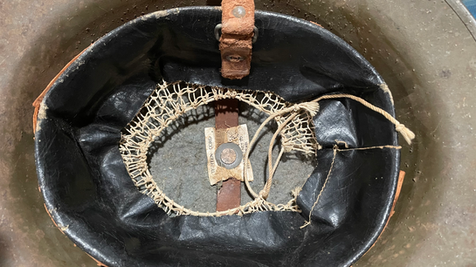


HELMETS/COVERS


Summer Officer Cover
Original-Jacob Reed and Son's WWI Cover
ARTIFACT: Excellent WWI United States Marine Corps Officer Undress Visor hat (cover) in summer khaki cotton with early EG&A. The officer's version of the Undress Visor features a braided quatrefoil and leather chin strap with blacked bronze buttons. The visor features an early, darkened bronze Eagle, Globe, and Anchor with applied continents. The inside has an excellent shaped a leather headband with the marking Jacob Reed and Son's Philadelphia, PA.
VINTAGE: Circa WWI
SIZE: Approximately Ear to ear: 7-2/8" Front to back: 8", 5" in height; EG&A: 1-1/2" x 1-7/8"
MATERIALS / CONSTRUCTION: Khaki cotton twill, wicker, braided quatrefoil, leather, blackened bronze
ATTACHMENT: EG&A: Single post with screwback
U.S. Marine Corps Dress Blue Enlisted Bell Crown Visor Cap
Item Description
This is a very nice condition U.S. Marine Corps Dress Blue "Bell Crown" visor cap, intended to be worn by Enlisted Men for dress and parade occasions. The name comes from the pronounced flare out towards the top of the cap. This cap is constructed of wool fabric stretched over a wicker inner frame. The cap features a WWI pattern black leather brim, supported by pressed paper or fabric. The brown leather sweatband is stitched to the body of the hat. The front of the cap bears the correct bright brass EGA for the "dress blue" scheme, with a black EM/NCO leather adjustable chinstrap with two USMC side buttons



USMC WWI M1917 Doughboy Helmet with Textured Paint
This very nice example complete with excellent liner and chinstrap that has original period col textured paint inand a genuine WWI USMC EGA! . This is a wonderful RARE example of a genuine USMC Great War helmet.
A wonderful totally original helmet with genuine original paint and even a bullet sized dent on the side!
The M1917 was the US Army's first modern combat helmet, used from 1917 and during the 1920s, before being replaced by the M1917A1. The M1917A1 helmet was an updated version of the M1917 and initially used refurbished WW1 shells.
The M1917 is a near identical version of the British Mk.I steel helmet, and it is important to note that when the US joined the Great War in 1917 they were initially issued with a supply of around 400,000 British made Mk.Is, before production began state side. The M1917 differed slightly in its lining detail, and exhibited US manufacture markings.
M1917 helmet liners typically show a paper label at the crown and the dome rivet head. The liner is set up as on the British versions, with an oilcloth band and net configuration, attached to a leather strap, riveted to the shell. The chinstrap is leather with steel buckle.
WWI USMC Campaign Cover
Brim Hand Marked
Jack D Bryan
Camp Knox KY
10th Infantry Company G
Prior to the adoption of 1912 regulations, officers and enlisted Marines wore a felt field “campaign” hat with a fore-and-aft crease. But, in 1912, the Corps adopted the now familiar “Montana peak” hat. Nearly 100 years later, this revered form of headwear continues service with rifle teams and drill instructors at San Diego and Parris Island.
The Marine Corps Pattern of 1912 (P1912) hat was also made of wool or fur felt and, outwardly, appear identical to the Army’s Model 1911 Campaign Hat and blocked to a point at the center of the crown with four “dents” around the point forming the distinctive “Montana Peak," about 5-3/4” high.
Closer examination, however, reveals the P1912 hat has a three-inch brim folded over and reinforced with two rows of stitching, whereas the Army’s hat is usually found with a raw-edged brim reinforced with three to five rows of stitching. Furthermore, the Marine hat has three vents in the crown but no rear vent.
Like the Army’s hat, a gross-grain silk ribbon encompasses the exterior base of the crown. These early hats were often fitted with shoestring chin cords anchored on the interior sides between the fur body and the leather sweatband.
Both officers and enlisted men were authorized to wear a bronze eagle, globe and anchor (EGA) insignia fastened through the front vent of the hat. In addition, Reserve officers wore a bronze “R” below the EGA. Enlisted personnel could also affix bronze numerals or letters below the EGA to denote their company. the top of the letter or the numeral was to "rest on top of the band, directly beneath the eyelet for the corps device."
Term of Service
The Montana peak hat, with very few modifications, remains in service to this day. Apart from a lowering of the peak to an overall height of about 5-1/2” and the addition of a leather chinstrap in 1916, the original P1912 hat remained virtually unchanged until 1920 when the reinforcing strip on the brim was abandoned but the two rows of stitching retained. A leather chinstrap was introduced at the same time making it very easy to distinguish a WWI-era hat from a later example.
-Military Trader
by D.L. Adams Sept 21, 2020

























